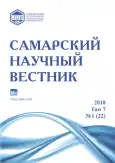Ecological and botanical features of the railroads flora of the Middle Volga Region
- Authors: Nikitin N.A.1
-
Affiliations:
- State University of Social Sciences and Education
- Issue: Vol 7, No 1 (2018)
- Pages: 91-97
- Section: 03.02.00 – General Biology
- URL: https://journals.rcsi.science/2309-4370/article/view/25352
- DOI: https://doi.org/10.17816/snv201871117
- ID: 25352
Cite item
Full Text
Abstract
The paper summarizes the study of ecological characteristics of the Railways flora in the Middle Volga Region. The author comes to the conclusion that in most cases there aren’t any significant differences between aboriginal and alien species of the Railways flora, as well as their settlement of functional zones. The most significant differences have been recorded between aboriginal and alien species in the addition of families, which in turn does not have a decisive role in their addition to the flora as a whole. The author thinks that ecological features of the territory of individual growth are more important than biological features of species and families in the formation of the Railways flora. The developed «scale of oppression» allowed to determine characteristics of a particular individual. In the course of the research the dependence between the degree of oppression of plant organisms and the distance to the railroad tracks was established. The author found no significant differences in reactogenicity between the indigenous and alien species at active human impact on the Railways - both groups showed similar trends of oppression.
Full Text
##article.viewOnOriginalSite##About the authors
Nikolay Alexandrovich Nikitin
State University of Social Sciences and Education
Author for correspondence.
Email: nikitin_nikolai@inbox.ru
postgraduate student of Biology, Ecology and Methods of Teaching Department
Russian Federation, SamaraReferences
- Агеева А.М., Силаева Т.Б. Материалы к адвентивной флоре Республики Мордовия (на примере Торбеевского района) // Российский научный мир. 2014. № 2 (4). С. 91-103.
- Березуцкий М.А. Антропогенная трансформация флоры // Ботанический журнал. 1999. Т. 84, № 6. С. 8-19.
- Сенатор С.А., Тохтарь В.К., Курской А.Ю. Материалы к флоре железных дорог Белгородской области // Вестник Удмуртского университета. Серия «Биология. Науки о Земле». 2016. Т. 26, № 4. С. 50-59.
- Литвинов Д.И. О южных заносных растениях на северных станциях Мурманской железной дороги // Изв. АН СССР. VI сер. Т. 20. Л., 1926. С. 59-66.
- Brandes D. Flora und Vegetation der Bahnhöfe Mitteleuropas // Phytocoenologia. 1983. Vol. 11. S. 31-115.
- Борисова Е.А. Инвазии древесных растений в природные сообщества Верхневолжского региона // Российский журнал биологических инвазий. Т. 9, № 1. 2016. С. 24-30.
- Galera H. et al. Encroachment of forest species into operating and abandoned railway areas in north-eastern Poland // Plant Biosystems. 2011. Vol. 145. P. 23-36.
- Gańko K. Pozatransportowe funkcje terenów kolejowych // Teka Kom. Arch. Urb. Stud. Krajobr. OL PAN, 2005. S. 216-225.
- Junghans T. Zur Flora der Hauptbahnhöfe von Mannheim und Heidelberg (Baden-Württemberg) // Braunschweiger Geobotanische Arbeiten. Т. 9. 2008. S. 9.
- Третьякова А.С. Роль железнодорожных магистралей в формировании синантропной флоры Среднего Урала // Экология. 2010. № 2. С. 102-107.
- Dřevojan P. Vedoucí B., Roleček M. Xerotermní flóra a vegetace zářezů železniční trati Veselí nad Moravou-Vrbovce // Masarykova univerzita Přírodovědecká fakulta Ústav botaniky a zoologie. Brno, 2010.
- Толмачёв А.И. Методы сравнительной флористики и проблемы флорогенеза. Новосибирск: Наука, 1986. 197 с.
- Маевский П.Ф. Флора средней полосы европейской части России. Изд. 10-е. М.: Т-во науч. изданий КМК, 2006. 600 с.
Supplementary files






